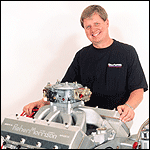 By David Reher, Reher-Morrison Racing Engines
By David Reher, Reher-Morrison Racing Engines
I am neither a golfer nor a golfing fan, but even I have heard about Tiger Woods. It seems there isn’t a national magazine, television news program, or newspaper that hasn’t featured golf’s latest multimillionaire. Woods’ success on the links has brought even greater success on his business ledger, with personal endorsements for everything from credit cards to sport shirts.
I know that buying a set of Tiger Woods golf clubs will not make me as good a golfer as he is. I have no illusions that owning a Mark McGwire baseball bat or a Michael Jordan basketball will make me a sports superhero. Unfortunately, some racers don’t understand that buying the parts used by successful drivers does not guarantee a place in the winner’s circle.
I’m not against heroes or endorsements. When I was a novice racer, I read the ads and articles in National DRAGSTER avidly to see what the fast guys were using. For a time, I had the mistaken belief that if I just had the same camshaft, the same cylinder heads, and the same tires as my heroes, I’d soon be basking in glory. I eventually found the flaw in that logic when I observed that some racers could win with parts that seemed hopelessly outdated, while other teams couldn’t win even with the best of everything. I realized that while good equipment is a prerequisite for winning, it is the skill and knowledge of the people turning the wrenches and driving the car that ultimately make the difference.
In a stick-and-ball sport, the importance of skill is obvious. No weekend golfer seriously believes that buying a set of Tiger Woods clubs will ensure an invitation to the Masters tournament. I know that wearing Michael Jordan’s shoes won’t help my three-point shot. Drag racing, on the other hand, is a mechanical sport. The emphasis on hardware tends to overshadow the importance of experience, tuning ability, and simple racing savvy.
I was recently reminded of the importance of the human element when I compared the on-track performance of two Reher-Morrison Super Series big-blocks. The engines were virtually identical, and were run in similar cars on the same 1/8th mile track. In spite of the similarities, one car was consistently quicker than the other.
I don’t know the exact reason for the difference in the performance of the two cars, but I know it wasn’t a significant difference in horsepower that was responsible. It might have been a case of a malfunctioning torque converter, an incorrect suspension setup, a bad shock absorber, a marginal fuel pump, an unsealed hood scoop, or any one of a hundred other possible problems.
As I’ve written before, race cars are incredibly complex devices. When you are totally focused on a problem, it’s easy to lose sight of the big picture – the classic forest and trees dilemma. There are days when I think that someone else could do a better job of running the Reher-Morrison Pro Stock Firebird than me, simply because another racer might bring a fresh perspective. If you convince yourself that the shock absorber valving is the source of your problems, you could easily overlook a broken rearend or a bent four-link.
Putting total faith in a computer program that predicts the performance of a race car can also be a blind alley. Some racers have a tendency to believe that software is infallible. Unfortunately, I’ve seen programs that have a tenuous connection to reality. For example, we know from experience that there are practical limits to how high the first gear ratio can be – yet one program I tested calculates continuous improvements in elapsed time as the first-gear ratio approaches infinity. The program only “knows” that increasing the first gear ratio multiplies engine torque, and therefore improves acceleration. The reality, of course, is that endlessly increasing torque multiplication also creates uncontrolled tire spin. Unless a racer has a solid base of experience to compare with the computer’s predictions, it is easy to have unrealistic expectations about a race car’s potential performance.
Instead of worrying about this week’s hot tip, it is more productive in the long run to pay attention to the equipment you already own – especially the parts that can cause big problems if they fail. Racers have a natural fascination with what’s new, unique, and trendy, but it is often the familiar and unglamorous pieces that deserve special attention. For example, when was the last time you thought about your engine’s roller lifters?
Roller lifters are among the most highly stressed and complex components in a racing engine, yet they seldom rate a second thought by many racers. If you have ever seen the damage that can be done by two dozen rock-hard needle bearings and a shattered roller wheel ricocheting around inside an engine, you might pay more attention to your lifters. Weak and worn valve springs can dramatically increase the loads on lifters because the valvetrain is unstable. My recommendation is to replace the roller lifters religiously after 200 runs. It’s cheap insurance.
Valves should also be replaced regularly. Like lifters, the valves can take a beating if the valve springs lose pressure. The cost of a set of top quality stainless valves is very reasonable when you compare it to the expense of repairing a block, piston, and cylinder head if a valve fails. Valves typically don’t show any signs of fatigue before it’s too late. That is why I recommend that racers replace the valves annually during an engine overhaul. You won’t pick up a tenth with new valves, but you can significantly extend the life expectancy of your motor.
And then perhaps you can afford a set of clubs just like Tiger’s!
